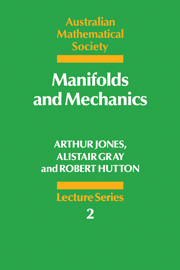Book contents
- Frontmatter
- Contents
- PROLOGUE
- 1 CALCULUS PRELIMINARIES
- 2 DIFFERENTIABLE MANIFOLDS
- 3 SUBMANIFOLDS
- 4 DIFFERENTIABILITY
- 5 TANGENT SPACES AND MAPS
- 6 TANGENT BUNDLES AS MANIFOLDS
- 7 PARTIAL DERIVATIVES
- 8 DERIVING LAGRANGE'S EQUATIONS
- 9 FORM OF LAGRANGE'S EQUATIONS
- 10 VECTORFIELDS
- 11 LAGRANGIAN VECTORFIELDS
- 12 FLOWS
- 13 THE SPHERICAL PENDULUM
- 14 RIGID BODIES
- REFERENCES
- INDEX
- SYMBOL TABLE
5 - TANGENT SPACES AND MAPS
Published online by Cambridge University Press: 28 January 2010
- Frontmatter
- Contents
- PROLOGUE
- 1 CALCULUS PRELIMINARIES
- 2 DIFFERENTIABLE MANIFOLDS
- 3 SUBMANIFOLDS
- 4 DIFFERENTIABILITY
- 5 TANGENT SPACES AND MAPS
- 6 TANGENT BUNDLES AS MANIFOLDS
- 7 PARTIAL DERIVATIVES
- 8 DERIVING LAGRANGE'S EQUATIONS
- 9 FORM OF LAGRANGE'S EQUATIONS
- 10 VECTORFIELDS
- 11 LAGRANGIAN VECTORFIELDS
- 12 FLOWS
- 13 THE SPHERICAL PENDULUM
- 14 RIGID BODIES
- REFERENCES
- INDEX
- SYMBOL TABLE
Summary
In the previous chapter the idea of differentiability was generalized so as to apply to maps between manifolds. In this chapter the idea of the derivative itself will be generalized to this context.
In order to retain the idea of differentiation as a process of linearization it will be convenient to introduce, at each point of a manifold, a vector space known as the tangent space at that point. These vector spaces will supply the domains and codomains for the linearized maps. A neat formulation of the chain rule then becomes possible via a generalization of the tangent functor, from Section 1.2, to manifolds.
Although all the concepts of this chapter can be formulated for arbitrary manifolds, our discussion will be restricted to submanifolds of Rn. This will provide an adequate background for later chapters on mechanics while avoiding unnecessary abstraction.
TANGENT SPACES
In elementary geometry one studies tangents to circles and tangent planes to spheres. The definition of a tangent space will generalize these ideas to arbitrary curves and surfaces and their higher dimensional analogues.
Let M be a submanifold of Rn and let a ∈ M. Intuitively, we want the tangent space at a to consist of all the arrows emanating from a in directions which are “tangential” to M at a, as in Figure 5.1.1. The arrows may be regarded as elements of the vector space TaRn, introduced in Section 1.2. To capture the idea of “tangency” we use parametrized curves in the manifold.
Information
- Type
- Chapter
- Information
- Manifolds and Mechanics , pp. 44 - 54Publisher: Cambridge University PressPrint publication year: 1987
